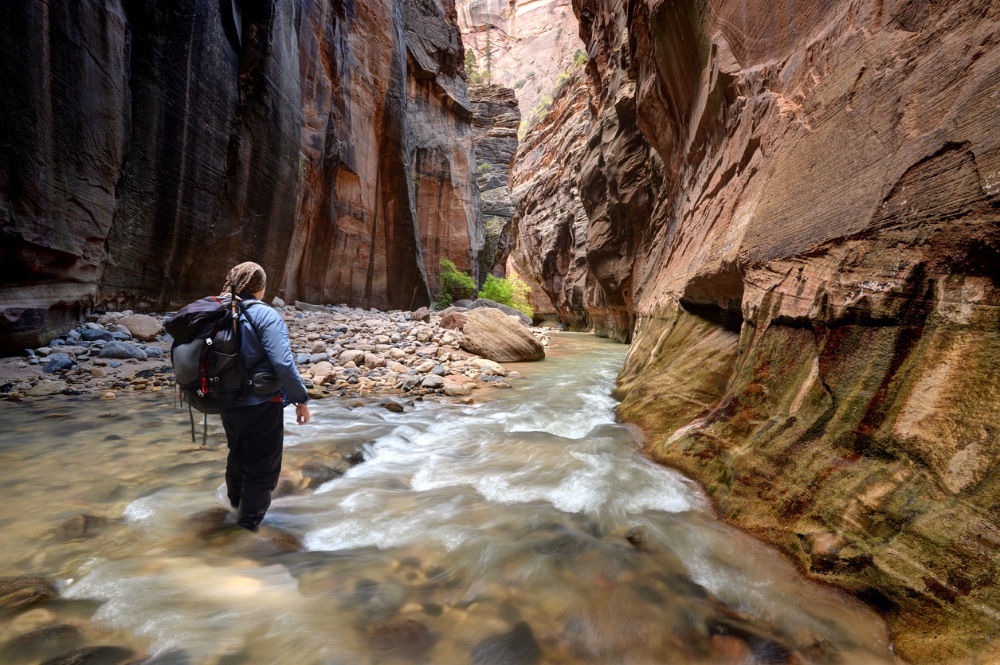Lack of Preparation for Hiking a Canyon in Winter
One winter long ago, I went on a hike with a friend. We began our journey at the mouth of a canyon whose walls rose more than a thousand feet above the river flowing below.
First, what we did not know:
- That nobody hiked this particular canyon in the winter. Ever. The hike required considerable time crossing a river and even swimming in it, and the water was ice cold in winter.
- That nobody did the hike “bottom-up,” which means the hiker begins at the bottom of the canyon and walks about seventeen miles to the top. “Bottom-up” requires walking uphill the entire distance, as well as walking and swimming against the significant river current. Normally the hike is done “top-down,” which is downhill all the way and with the flow of the river.
- That nobody, including park rangers, had ever HEARD of anyone dumb enough to hike the canyon “bottom-up” in the winter. The hike “top-down” takes 12-14 hours in the summer.
- That a permit was required to hike the entire canyon, even “top-down.”
- That there was a large fork in the river several miles upstream from the bottom. One fork led to a highway, while the other wandered out into remote desert. Without a map, it would be easy to take the wrong fork and die of exposure far from everywhere.
- That people taking the hike were consistently well-prepared with food, water, equipment, and weather forecasts, since almost every year people had died from flash floods
From the moment we stepped into the water at the canyon mouth, we should have known we’d made a bad decision. The water was as cold as the ice floating on its surface, and in many places the water extended from one wall of the canyon to the other, so we could only wade or swim through the water.
We were athletic, strong hikers, but still the progress was slow. Every step was uphill and against the river’s flow. Sometimes we had to swim upstream, which was exhausting and also drained the heat from our bodies faster than I would have thought possible.
In several places the wall-to-wall water was covered with ice, which we had to break with our fists and forearms. Repeatedly we had to building fires so we could overcome our hypothermia and regain the feeling in our legs. This was no longer a merry jaunt, but we just kept taking one more step.
We had prepared poorly for our trip. We didn't take clothing sufficient for the cold. For food we had a box of crackers, some raisins, and a few other odds and ends. We were 18-y.o. kids. We had no map, and our only instructions had come from someone who'd walked downstream in the summertime. We'd been told, however, that eventually we'd come to a small cabin where a dirt road led to the highway.
As the sun disappeared, there was no sign of the cabin, and the walls of the canyon were still hundreds of feet above us. We were exhausted, hungry, and frozen. We settled down for the night, sleeping so close to the fire that repeatedly we were awakened by flames consuming our sleeping bags.
The next day we continued our trek. The winter jaunt had turned into a slogging nightmare that continued all the second day and well into the night. We finally gave up and made camp, worn out and shivering. The food was long gone, and we were drinking muddy water strained through our clothing. Again the night was interrupted by sleeping bags on fire.
When we awoke the next morning, less than a hundred yards away we saw the empty cabin we’d heard about, across the river. If we had walked two more minutes the night before, we'd have eaten a hot meal and slept in warm beds. We hitchhiked to our car back at the mouth of the canyon and drove home.
Preparation for Parenting Like Hiking a Canyon In Winter
Now, fifty years later, it occurs to me that hiking the canyon in winter was similar in many ways to parenting our children:
- No education. Just as we hikers had no idea what we would face in the canyon, nobody gave us any clue what parenting would be like. We know that we’re supposed to feed and shelter our children, but we do that for chickens and cows. We don’t know what to do when they become demanding, angry, afraid, and confused. The laugh tracks on sitcoms are not the kind of education we needed. Parenting is often depicted as natural and easy, with scenes of young mothers cooing over an infant. We see visions of parenting happening on a warm summer day, while in reality parenting often is walking and swimming uphill in freezing water.
- No preparation. Imagine how much easier my hike would have been if we’d been better equipped with clothing, boots, food, water, a map, and even a guide to hold our hand. As parents we are not given the equipment—the love and the wisdom—required to raise loving and responsible children.
- Fires. In the midst of daily routine, parenting is putting out one fire after another, just as we did in the canyon while trying to sleep close to the hot coals.
- Persistence. We succeeded in climbing the canyon through a river of icy water because we just kept taking one more step. In parenting, we have to do the same. When in doubt about what you’re doing, keep moving. One particular step may not appear to lead anywhere, but they accumulate and interconnect, and eventually you will see miracles you never anticipated.
Now, imagine what it would be like to have adequate supplies, a map, and a guide for your journey as a parent. You’re getting that right now. You have the Parenting Training to guide you.
You get written answers, video answers, and conference calls every week to fill out the map. You have access to experienced Real Love parents who will hold your hand as you walk upstream. It gives you all the preparation for parenting you could hope for.
Keep putting one foot in front of the other, even when you slip on the rocks in the river bed, and when your feet are so cold you barely feel them. Keep going, and you’ll reach a place of peace and confidence, which is worth all the steps required to reach it.


